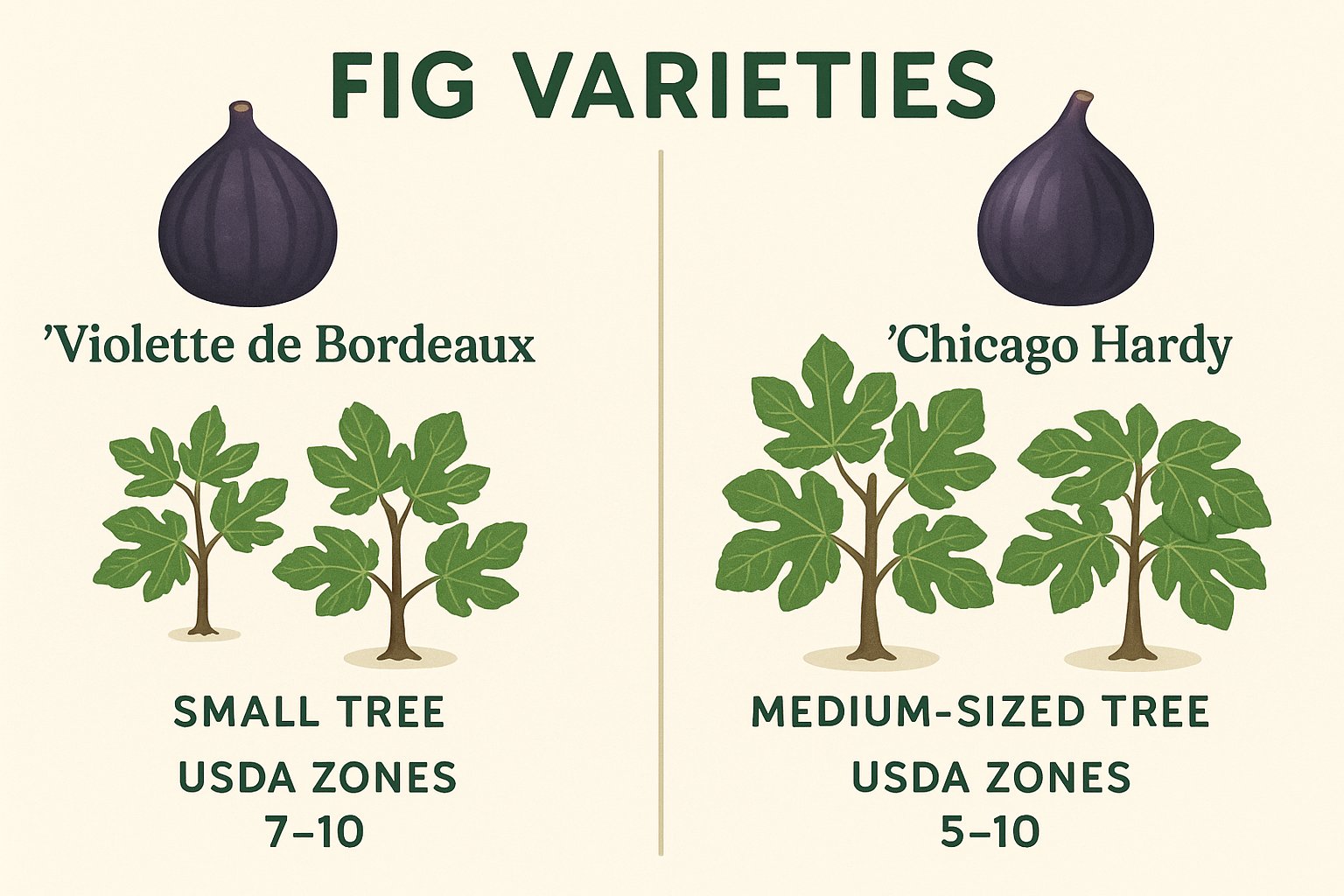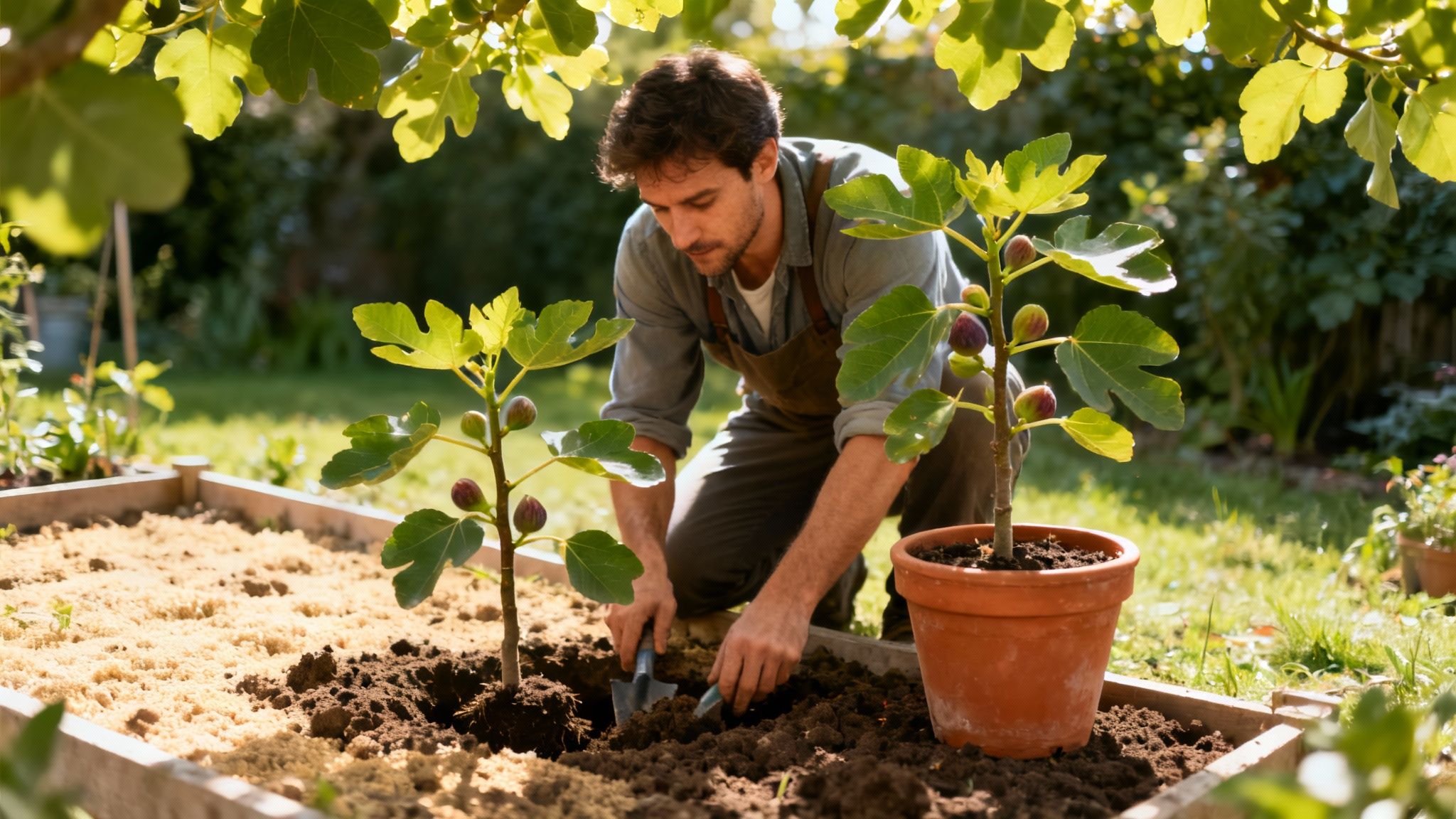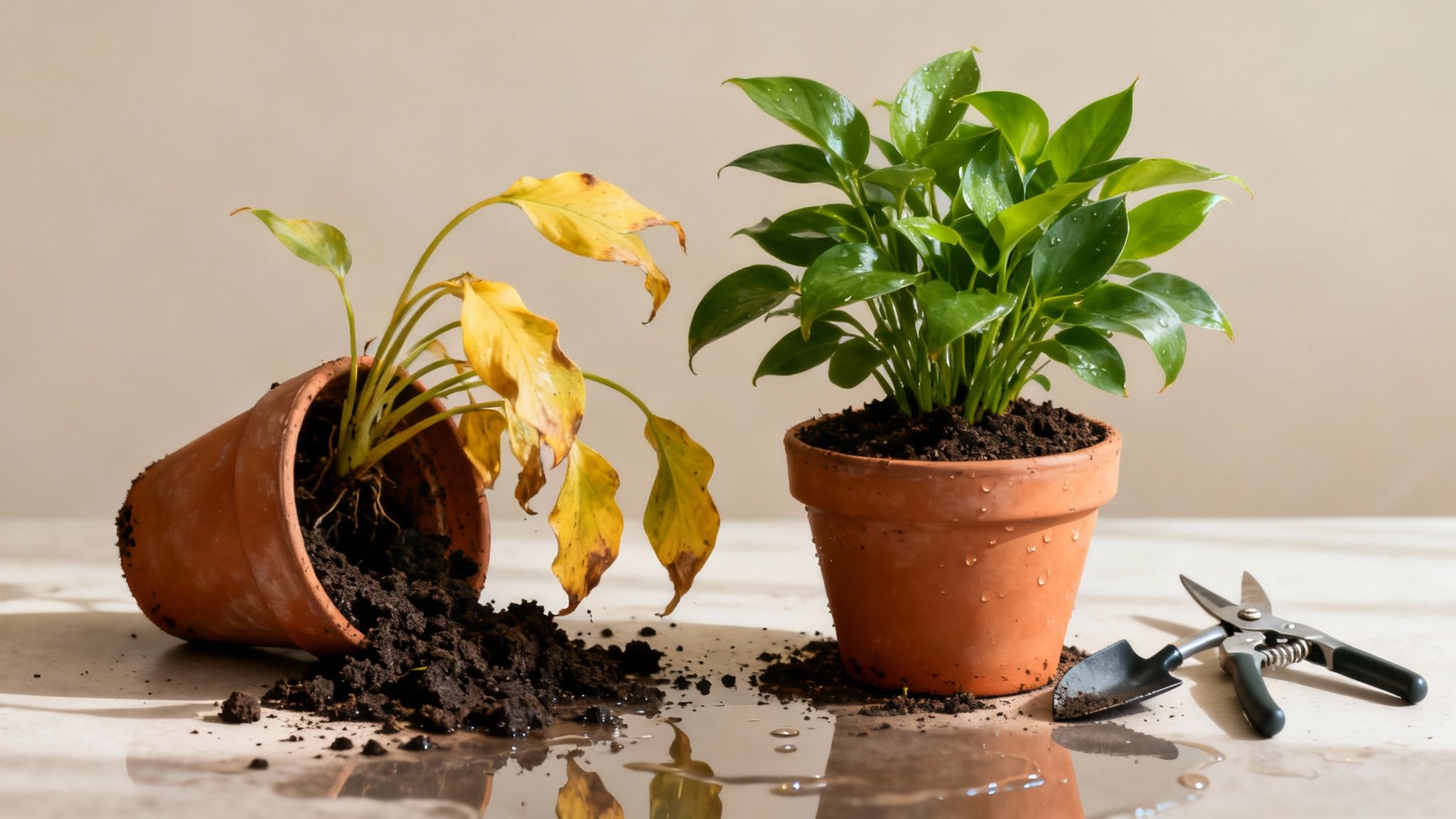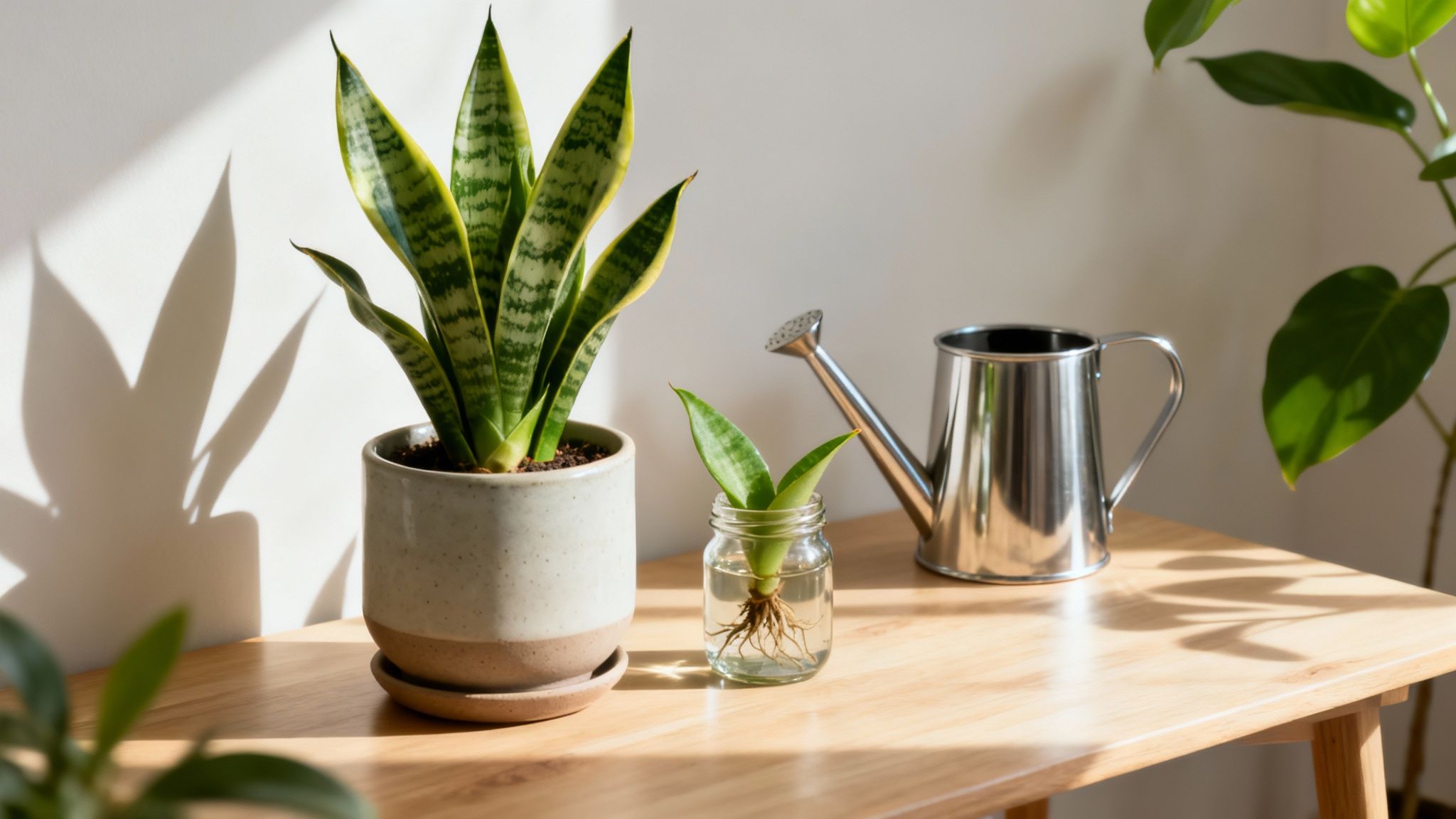Ever tasted a sweet, sun-warmed fig picked right from the branch? It's a world away from the often-disappointing versions at the grocery store. Growing your own is a truly rewarding experience, but the idea can feel intimidating. This guide is your complete fig trees 101 roadmap, designed to take you from a curious beginner to a confident grower, ready for that first amazing harvest. With a little knowledge and the right tools, you'll see just how simple it can be to bring this ancient delicacy to your own garden.
Your Fig Growing Journey Starts Here
The dream of homegrown figs is easy, but questions can pile up fast. What kind of soil do they need? How much sun is too much? What's the deal with pruning? It's enough to stop many would-be gardeners in their tracks. But here’s the good news: growing these delicious fruits is far more straightforward than you might think. With a few key principles, you can cultivate a thriving tree that rewards you for years to come.
This guide breaks it all down into simple, manageable steps. We'll walk you through everything you need to know:
Variety Selection: How to choose the perfect fig variety (Ficus carica) that will thrive in your specific climate and garden space.
Planting Techniques: Mastering the simple but crucial steps for planting in the ground or in a container.
Essential Care: The straightforward routines for watering, feeding, and pruning that will lead to a tree loaded with fruit.
Harvesting Tips: Learning how to spot the exact moment a fig is perfectly ripe for peak sweetness and flavor.
Sometimes, the best advice comes from someone who's already succeeded in your area. That’s where a community becomes your superpower. On Tendra, you can connect with local gardeners—your Twin Plant Mates—who've cracked the code for growing figs in your climate. Imagine getting hyper-local tips on which varieties perform best or how to handle a specific pest in your neighborhood. Let's get growing.
Choosing the Perfect Fig Variety
Your entire fig-growing journey hinges on one decision: picking the right tree. With hundreds of varieties, the first lesson in fig trees 101 is simple: match the plant to your environment. For most home gardeners, the focus should be on Common Figs. These are superstars because they are self-pollinating (parthenocarpic), meaning they produce fruit without needing another tree or a special fig wasp for pollination. This detail strips away a massive layer of complexity, making your job much easier.
Understanding Your Climate and Space
Before you get swept away by descriptions of rich, jammy flavors, you have to assess your growing conditions. The most critical piece of the puzzle is your USDA Hardiness Zone. This tells you which trees can survive the coldest winter temperatures in your area. A gardener in a balmy Zone 9 has endless options, but if you're in a chilly Zone 6, you absolutely need a variety known for its cold tolerance. You can learn more in our gardener's guide to the USDA planting zone chart.
Next, consider your physical space. Some fig trees become large, sprawling specimens, while others are naturally more compact—perfect for smaller yards or containers.

Top Fig Varieties for Home Gardeners
To get you started, let's look at a few reliable and beloved common fig varieties. Each brings something different to the table, and Tendra’s extensive cultivar database can help you explore even more options suited to your specific climate.

‘Brown Turkey’: Often called the quintessential beginner's fig, this tree is incredibly adaptable and a famously heavy producer. It gives you medium-sized, brownish-purple figs with a mild, sweet flavor. A dependable workhorse for zones 7-10.
‘Chicago Hardy’: The undisputed champion of cold climates. It can survive winters down into Zone 5 or 6, often dying back to its roots and then roaring back to life in spring to fruit on the new growth. The figs are a bit smaller but pack a rich, satisfying punch.
‘Celeste’: Often referred to as the "Sugar Fig," this variety yields small-to-medium light brown or violet figs with an intensely sweet, dessert-quality taste. It features a "closed eye" (the small opening at the bottom), which helps prevent insect intrusion. Ideal for zones 7-10.
‘Violette de Bordeaux’: A gourmet favorite, this compact tree produces small, deep purple-to-black figs with vibrant red pulp. The flavor is rich and complex, often likened to raspberry jam. Its smaller size makes it well-suited for container growing.
‘Tiger Panache’: Known for its unique appearance, this variety offers strikingly striped green and yellow figs with a sweet, honey-like flavor. It is well-adapted for growing in warmer climates and can be a delightful addition to any garden.
Choosing a variety isn’t just about survival; it's about selecting a flavor you'll love and a growth habit that fits your life. Don't just pick the most popular one—pick the one that's right for you.
Planting Your Fig Tree for Long-Term Success
You’ve picked the perfect fig variety, and now it’s time for the most important moment in its young life: planting. Getting this part right dictates the health, stability, and fruitfulness of your tree for decades. This is the hands-on part of fig trees 101, where all your prep work meets the soil.
 small fig tree in a sunny garden spot, with a bag of compost nearby.">
small fig tree in a sunny garden spot, with a bag of compost nearby.">
Whether you’re planting in the ground or in a container, a fig tree’s fundamental needs don't change. They crave two things more than anything: tons of sun and soil that drains well. Nail these two, and you’ve already won half the battle.
Choosing the Ideal Planting Site
Before your shovel touches the dirt, find the sunniest spot you have—one that gets at least 6-8 hours of direct, unfiltered sunlight daily. More sun means more energy, which translates directly into more figs. In cooler climates, a spot near a south-facing wall is a bonus, as the wall radiates heat and creates a cozy microclimate.
In-Ground Planting Step-by-Step
If you have heavy clay soil, you'll need to do a little prep work. If your soil is sandy or loamy, you're in great shape.
Dig the Right Hole: Make the hole twice as wide as the root ball but only just as deep. This encourages roots to spread outward.
Amend the Soil: If you have clay soil, mix the dirt you dug out with a generous amount of compost (about one part compost to two parts native soil). This improves drainage and adds crucial organic matter.
Position the Tree: Gently loosen any circling roots and place the tree in the hole, ensuring the top of the root ball is level with or slightly above the surrounding ground. Planting too deep is a common mistake that invites root rot.
Backfill and Water: Fill the hole with your amended soil, tamping it down gently to remove air pockets. Give the tree a deep, thorough watering right away.
Practical Tip: Spread a 2-3 inch (5-7.5 cm) layer of organic mulch like wood chips around the tree's base, but keep it a few inches away from the trunk to prevent rot.
Container Planting for Flexibility
Growing a fig tree in a pot is a fantastic choice for gardeners in colder zones or those with limited space.
Pot Selection: Start with a pot that’s about 18-20 inches (45-50 cm) across with plenty of drainage holes.
The Perfect Mix: Use a high-quality potting mix, not garden soil. Look for a mix with perlite or vermiculite for excellent drainage.
Planting Process: Fill the pot partway with your mix, set the tree inside so the top of its root ball is an inch or so below the pot's rim, and fill in the gaps. Water it well until water runs freely from the drainage holes.
Mastering Daily Fig Tree Care
Now the real fun begins. Keeping a fig tree thriving is about mastering a few daily and weekly essentials. This is the core of our fig trees 101 guide—turning knowledge into simple, practical actions.
The Art of Watering
The most common stumble for new fig growers is watering. Figs hate "wet feet" (soggy soil) but get incredibly thirsty, especially when setting fruit. The solution is the "finger test." Before you grab the hose, stick your index finger about 2 inches (5 cm) into the soil.
If it feels dry at your fingertip, it's time to water deeply.
If it feels moist, hold off and check again tomorrow.
When you do water, do it thoroughly. For container figs, water until it flows from the drainage holes.
Fertilizing for Fruitful Growth
Feeding your fig tree is a balancing act. Too much fertilizer creates a leafy bush with no fruit. Here’s a simple schedule:
Early Spring: As new growth appears, apply a balanced, all-purpose fertilizer (like 10-10-10).
Late Spring/Early Summer: About six weeks later, apply a second, smaller feeding.
Stop by Mid-Summer: Don't fertilize after late July. Late-season feeding encourages tender new growth that's vulnerable to frost.
Sustainable Pest and Disease Management
A healthy fig tree is resilient, but problems can arise. The goal is to spot issues early and use gentle methods.
Spider Mites: Tiny pests that cause a stippled look on leaves. A strong blast of water often dislodges them.
Fig Rust: Small, yellowish-orange spots on the undersides of leaves. Good air circulation from proper pruning is your best defense.
Problem-Solution Scenario: You notice strange spots on your fig leaves and aren't sure if it's a pest or a fungus. Instead of guessing and potentially using the wrong treatment, you need a clear answer fast. This is where technology can be a gardener's best friend. With Tendra's AI disease diagnosis feature, you can snap a photo, and the app will instantly analyze it, identify the problem, and provide a practical, sustainable treatment plan. You can learn more in our guide to identify plant diseases and save your garden in our detailed guide.
The Art of Pruning Your Fig Tree
Pruning often feels intimidating, but for fig trees, it's the most powerful tool for a massive harvest. Most common fig varieties produce their main crop on new wood—the growth from the current season. Strategic cuts tell the tree exactly where to put its energy.
Why and When to Prune
A properly pruned tree has an open, airy structure that lets sunlight and a breeze reach every part of the plant. This leads to:
More Fruit: You stimulate the new growth where figs actually form.
Better Ripening: Sunshine hitting the developing figs helps them ripen evenly and taste sweeter.
Disease Prevention: Good airflow helps leaves dry quickly, preventing fungal issues.
Easier Harvest: Shaping the tree keeps it at a manageable size.
The absolute best time to prune is during winter dormancy, after the leaves have dropped but before new buds swell.
How to Make the Right Cuts
Your goal is to shape the tree into an open, vase-like form. Start by removing any problem branches:
Dead, Damaged, or Diseased Wood: Cut these back to healthy wood.
Suckers: Snip off any shoots coming from the base of the trunk.
Crossing or Rubbing Branches: Remove any branches that are growing into each other.
Inward-Growing Branches: Get rid of branches growing back toward the center of the tree.
After this cleanup, a good rule of thumb is to prune a mature tree back by about one-third each winter. This is what kicks that all-important new growth into gear.
Surprising Fact: Did you know a fig isn't actually a single fruit? Botanically, it's an inflorescence—a fleshy, inverted stem holding hundreds of tiny flowers and seeds inside. When you bite into a fig, you're eating a whole bouquet!
Harvesting Your Homegrown Figs
This is the moment all your patience has been leading up to. Unlike many other fruits, figs will not ripen after being picked. Learning to spot the signs of peak perfection is the final, crucial skill in your fig trees 101 journey.

Reading the Signs of Ripeness
Look for a combination of these signals:
Color Change: The fruit will deepen into its mature color (purple, brown, or golden green, depending on the variety).
Gentle Droop: The "neck" of the fig will soften, causing the fruit to hang down. A fig pointing straight out isn't ready.
Soft Texture: A ripe fig feels soft and gives a little when you apply gentle pressure, much like a perfect peach.
Practical Tip: When you think it's ready, gently hold the fig by its neck and give it a slight twist as you pull. A perfectly ripe fig will practically fall into your hand. If you have to tug, it needs more time on the branch.
Conclusion: Connect, Grow, and Share Your Harvest
You now have the fundamental knowledge to successfully grow your own delicious figs. From choosing the right variety for your climate to mastering the simple arts of planting, watering, and pruning, this fig trees 101 guide has set you on the path to an abundant harvest. Remember that every successful garden starts with one small, well-informed step. The key is to stay curious, observe your plant, and not be afraid to learn as you go.
Gardening is always better when shared. You don’t have to solve every puzzle alone. When you have a question or want to share your success, a whole community is ready to help. Find your plant's local growing partners with Tendra, where gardeners connect, grow, and share.






